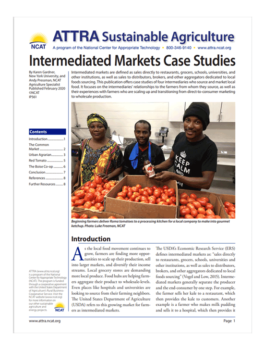Intermediated Markets Case Studies
By Karen Gardner, New York University; and Andy Pressman, NCAT Agriculture Specialist
Abstract
Intermediated markets are defined as sales directly to restaurants, grocers, schools, universities and other institutions, as well as sales to distributors, brokers, and other aggregators dedicated to local foods sourcing. This publication offers case studies of four intermediaries who source and market local food. It focuses on the intermediaries’ relationships to the farmers from whom they source, as well as their experiences with farmers who are scaling up and transitioning from direct-to-consumer marketing to wholesale production.
Contents
Introduction
As the local food movement continues to grow, farmers are finding more opportunities to scale up their production, sell into larger markets, and diversify their income streams. Local grocery stores are demanding more local produce. Food hubs are helping farmers aggregate their product to wholesale-levels. Even places like hospitals and universities are looking to source from their farming neighbors. The U.S. Department of Agriculture (USDA) refers to this growing market for farmers as intermediated markets. The USDA’s Economic Research Service (ERS) defines intermediated markets as: “sales directly to restaurants, grocers, schools, universities and other institutions, as well as sales to distributors, brokers, and other aggregators dedicated to local foods sourcing” (Vogel and Low, 2015). Intermediated markets generally separate the producer and the end-consumer by one step. For example, the farmer sells her kale to a restaurant, which then provides the kale to customers. Another example is a farmer who makes milk pudding and sells it to a hospital, which then provides it to its patients. The key factor in intermediated markets is that all parties involved are making a values-based decision to support local agriculture. This includes paying the premium price that local agriculture demands.
The key factor in intermediated markets is that all parties involved are making a values-based decision to support local agriculture.
There are four general types of intermediated markets:
- Retail, including small groceries (not buying from wholesalers) and food co-ops
- Restaurants
- Food hubs and aggregators
- Institutions, such as hospitals, schools, universities, prisons, and elder-care centers
This publication presents case studies of four intermediaries who source and market local food. It focuses on the intermediaries’ relationships to the farmers from whom they source, as well as their experiences with farmers who are scaling up and transitioning from direct-to-consumer marketing to wholesale production. The case studies are of The Common Market, a nonprofit local food distributor working out of Philadelphia, Pennsylvania, and Atlanta, Georgia; Urban Agrarian, a local grocer and food distributor in Oklahoma City, Oklahoma; Red Tomato, a produce distribution nonprofit in Plainville, Massachusetts; and The Boise Co-op, a retail cooperative in Boise, Idaho. Author Karen Gardner of New York University conducted a series of interviews in 2017 to create these case studies. Each of these case studies provides examples of how a buyer can effectively build a relationship with a farmer. Forming that relationship is the core of the marketing work that a farmer needs to do to break into an intermediated market.
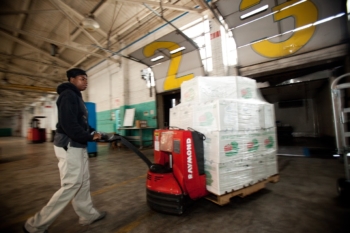
Stella Jones, former Common Market Warehouse Manager, moving produce in the warehouse. Photo: The Common Market
The Common Market
The Common Market is a nonprofit, local food distributor. It works with around 80 family farms in its flagship location in the mid-Atlantic area to aggregate products in order to access wholesale markets, with a specific focus on institutions that serve a broad community. Almost half of its product is sourced by schools, with the remaining sourced by hospitals, workplaces, retailers, and restaurants. Founded in 2008, The Common Market replicated its model in Atlanta in 2016 to serve the southeast and is currently expanding to Texas, as well.
Relationships with Farmers
Tatiana Garcia Granados, co-founder and Chief Operations Officer, says that the nonprofit’s ability to work with many different local farmers is its core competency. The Common Market works with numerous suppliers, aggregating their products to supply a predictable, high-quality product to institutional buyers. When beginning a relationship with a grower, it looks for sustainable growing practices and wholesale readiness, including good post-harvest handling practices, humane practices with animals, and minimal use of chemicals. In the mid-Atlantic, The Common Market requires farms to have Good Agricultural Practices (GAP) certification. GAPs are voluntary food-safety guidelines that farms follow to reduce the risk of foodborne illnesses. It took five years for all of the farmers they source from in the mid-Atlantic to get GAP certified, and The Common Market was able to assist these farms through networking and a cost share for audits and training, without losing any farmers in the process. The Common Market is now beginning this process with the farms they work with in the southeast. Granados says that open communication is the most important part of The Common Market’s relationships with farmers. They work to be open and honest about expectations, holding crop planning meetings with farmers once a year to go over what happened during the year and what to expect for the next year. “You can work through a lot of issues on both sides if you’re honest with each other and look for solutions together,” Granados said (Granados, 2017). In the southeast, the nonprofit was having issues with produce quality and started communicating feedback to farmers every time it received product. She explains that, while it seemed cumbersome at first, the farmers appreciated the regular communication and the call became part of the nonprofit’s flow, vastly improving product quality.
Wholesale Readiness and Scaling Up
The Common Market may be the first wholesale intermediary many of its farmers have ever worked with. Granados says that the nonprofit doesn’t look for farmers who are already selling to intermediaries, since part of its work is to support growers who want to transition into wholesale marketing. She says the biggest challenge is price point. Not only must there be enough regional and local demand for local farmers to grow to scale but, in order for institutions to demand local food, the prices must also be low enough. Granados says that The Common Market represents 10 to 20% of sales for most of the farmers from whom it sources. These farmers are diversifying their markets in order to decrease risk, especially while starting new marketing relationships.
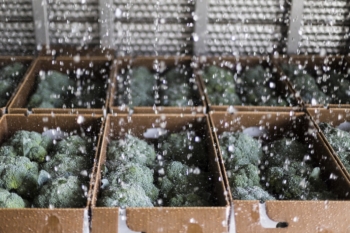
Broccoli at Sunny Harvest Farm in Lancaster County, Pennsylvania. The Common Market helped the farm build a hydro cooler to take field heat off vegetables and extend the growing season. Photo: The Common Market
Food safety is a high priority for farms in The Common Market’s network that are transitioning to wholesale readiness. There is high demand for light processing (such as washed salad greens or pre-peeled and cubed winter squash) and other aspects of uniformity that make products easier to handle for institutions ordering on a large scale. “I think in some respect the paradox of serving the wholesale market is you have to do more and work harder for less money, and you have to have decided that you want to take your business to a scale where you can make that equation work,” Granados said. Some of the farmers from whom The Common Market sources have scaled up by aggregating themselves, rather than scaling up their farm. The nonprofit works with several aggregation sites in both the southeast and the mid-Atlantic regions. For instance, The Common Market works with the Northern Alabama Food Bank, which aggregates local farm products as a means of marketing and wealth creation for the community. Similarly in the mid-Atlantic, one aggregation site is simply a refrigerated trailer on an Amish farmer’s land where other nearby farmers bring their products.
Urban Agrarian
Matthew Burch founded and manages Urban Agrarian, a local grocer and distributor in Oklahoma City, Oklahoma. Locally grown and prepared foods are the driving force of Burch’s business, with the vast majority of his products sourced within a 200-mile radius, and almost everything he sells originating from inside of the state. He primarily purchases directly from farms, and he has long-standing relationships with a great many farmers in his region.

Matthew Burch at one of Urban Agrarian’s farmers market booths. Photo: Chelsey Simpson
“In our model, the most valuable member is the grower.” — Matthew Burch, Urban Agrarian
Relationships with Farmers
Burch cares deeply about his relationships with the farmers from whom Urban Agrarian sources. It is important to have a sense of empathy and understanding, he says, in order to structure an agreement that works for both Urban Agrarian and its partner farmers. Burch thinks that the industrial agriculture food chain values the marketer over the grower and points out that, “in our model, the most valuable member is the grower” (Burch, 2017). Burch is currently structuring his sourcing plans by estimating his demand for a product and dividing that number in half, creating a plan with two different farmers who will each supply half of his need for that product for the year. This way, if Urban Agrarian needs more product than expected, there is a good chance that one of the growers will have extra to sell. At the same time, if the crop fails for either grower, Urban Agrarian will still be able to sell the crop, taking some pressure off the farmers. Burch says that most of his farmers are growing food on land outdoors, so some crop failure is inevitable, and it’s important that the farmers he works with are able to tell him when it does. Urban Agrarian gives preference to growers with USDA organic certification, most other certifications, and GAP training, but it remains flexible and realistic. Hailing from and working in Oklahoma, Burch says his pricing plan is inspired by a natural gas pricing model: the take-or-pay contract. This means that Burch provides a price and quantity floor for growers, a defined minimum amount that he will accept, and if he is not able to take it, he will still pay for the product. Urban Agrarian does face challenges apart from crop failure, particularly based on capital. In fact, it took a long time for the small business to turn a profit and invest in the infrastructure it needed, closing its doors once but re-opening with resounding community support. Burch says that the business has at times faced challenges that come with personal disagreements. Things get more personal than they would in other industries – [farmers] pour their heart and soul into their product,” he explained.
Wholesale Readiness and Scaling Up
According to Burch, the primary challenges for farmers transitioning from direct-to-consumer marketing outlets, like farmers markets and CSAs, to working with Urban Agrarian are creating uniform packaging sizes and quality, and ensuring efficiency. He says that, in his experience, growers who have found ways to build or obtain the appropriate amount of cold storage have done much better than those who haven’t. Another big challenge for transitioning farmers has been finding strong but inexpensive boxes or finding a way to efficiently wash and sanitize crates. Most important to a farmer’s scaling-up process is the ability to fix things, he says, as something will inevitably break during the season. Scaling up can be difficult for small farmers, as infrastructure is expensive. Burch says that if a grower doesn’t start with all the tools he needs, it’s difficult to turn a profit, but without turning a profit, it is hard to then purchase those tools. He says he’s also seen farmers scaling up too fast, taking on too much and then being derailed by an unexpected event or by weather. He’s also seen scaling up work, most often when a farmer sells to several different buyers, diversifying to lower the risks. Most of all, Burch say that for Urban Agrarian, the benefits of working directly with local farmers comes from “putting money directly into the community.” He says the quality of local food is incomparable and he and his staff really enjoy investing in local Oklahoma growers and bringing the market to them.
Red Tomato
Founded in 1997, Red Tomato is a produce-distribution nonprofit that brings local food to grocery stores in a nine-state region of the Northeast. While initially operated with a warehouse and trucks, the decision-makers at Red Tomato realized that they could be more efficient and better serve both farmers and customers by managing the supply chain rather than serving as another link in that chain. Red Tomato works with retail supermarkets to help them source locally from wholesale-ready farms. Red Tomato also developed an ecologically grown fruit certification program for apples and peaches. The Eco program is based on the most advanced Integrated Pest Management (IPM) practices, specific to the Northeast. Fruit growers in the Eco program follow region-appropriate growing protocols without sacrificing the integrity of the environment. The Eco label supports Red Tomato’s marketing position that also includes regional farm identity, fair prices, and farm worker safety.
Relationships with Farmers
Michael Rozyne, founder of Red Tomato, says that the nonprofit begins relationships with new growers slowly, listening carefully to learn about the grower’s relationship to quality control and establishing realistic expectations early on. To work with Red Tomato, a grower must have a wholesale business plan in mind. Red Tomato also requires that growers have a food safety certification (at least GAP certification), and be willing to assist growers who are struggling to get certified.

Red Tomato helps to lower packaging costs for growers by coordinating purchases of different types of packaging, including those for peaches from Lyman Orchards in Middlefield, Connecticut. Photo: Red Tomato
Susan Furtell, Director of Marketing at Red Tomato, says that with every new grower, and often with a new product, Red Tomato conducts a farm visit and engages in an in-depth conversation. The nonprofit plans over the winter, working out practicalities and expectations, and then speaks with farmers regularly throughout the season. If Furtell gets a call about a problem with either a farmer or a customer, she looks into it immediately to find a solution as quickly as possible. It’s important to Red Tomato to, whenever possible, have more than one supplier for any product. Red Tomato’s customers are looking for a long season and consistent supply, and Furtell says that working with a group of growers allows Red Tomato to meet demand and bring local food to the large grocery stores.
Wholesale Readiness and Scaling Up
Furtell says that Red Tomato typically works with multi-generational farms that are wholesale-ready, but on occasion the nonprofit will work with smaller growers who are just getting started in wholesale. In all cases, when it brings on a new grower or a new customer, Red Tomato works to develop quality standards and to learn what the customer is looking for and what the grower can provide. Questions to customers might include: Do you only sell top-grade? What size of this product do you sell? What packaging would you like? What shelf life do you need? Questions to growers include: What is your experience growing this product? At what price are you looking to sell the product? If a grower is interested in trying out a new product, Red Tomato will test the product on a small scale for a season and expand slowly the next season, coordinating with customers who are also interested in purchasing that product. Rozyne emphasizes that for new growers, there will be challenges that they might not be accustomed to when first selling to intermediaries. For instance, packaging can be a difficult problem to solve. Finding packaging that is affordable and achieves uniformity is much more complicated for a decentralized supply chain like Red Tomato’s. With some of the initial challenges, Rozyne says that informal farmer-to-farmer mentorship can be very helpful. He has observed more experienced growers helping younger, newer growers, especially if they are in the same area. Furtell says that this is particularly helpful with Red Tomato’s EcoApple® and EcoPeach® networks because farmers can reach out to each other with questions. Red Tomato does not operate any mentorship program but may suggest a grower nearby who could provide support to a new grower in its network. On the whole, Rozyne says that the benefits of making supply chains more efficient in order to bring local food to grocery stores are innumerable. “If there are too many chain links, it will drive the costs off the table,” he said (Rozyne, 2017). He works to eliminate all redundancy and do what’s useful because “if it’s not competitive, we’re not helping anyone.”
The Boise Co-op
The Boise Co-op was started in 1973, as a buying club that operated out of a neighborhood living room. It moved into a community center and then started a retail space in the early 1980s. In the years since, the co-op has continued to grow and now operates two retail grocery stores, a pet-supply store, and a wine store. The co-op currently has 27,000 active members (people who have shopped in the last year). The Boise Co-op sources locally and is constantly looking to increase its offering of local products. Sourcing locally can be a challenge in Idaho, as the growing season is short, but it is one of the co-op’s core principles and its marketing to do so. The co-op brings attention to local products throughout the store with local tags and displays photographs of local vendors, with full vendor profiles on its website.
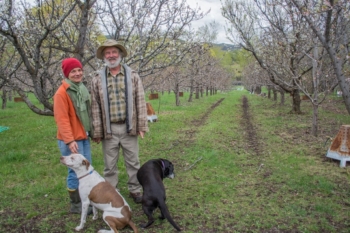
Rob and Linda Cordtz, of Eagle Creek Orchard, who grow fruit for the Boise Coop. Photo: Mo Valko, Boise Consumer Co-op
Relationships with Farmers
In its 45 years of operation, the Boise Co-op has learned a lot about building mutually beneficial relationships with farmers. Mo Valko, the co-op’s marketing manager, remarks that farmers tend to be a pretty independent group of people and not, on the whole, particularly technologically savvy. She says that one thing the co-op has learned over the years is that it is easiest for everyone if the co-op provides a template for things like invoices and availability charts, so that after doing all the hard work of growing food, farmers just have to sit down and input the information rather than creating new systems. When the Boise Co-op is beginning a relationship with a farmer, co-op staff will start a conversation to find out what the farmer’s growing practices are. The co-op gives preference to growers who are certified organic or who are using organic production practices but do not have the means to get certified. They look for growers who can fill gaps in their supply, providing new or different products. The co-op then sends the grower their product standards, and works to set clear expectations for both the co-op and the grower from the outset. Valko stresses the importance of clear and consistent communication. The co-op holds meetings with its farmers in the off-season to decide who the primary and secondary producer of each crop will be and to set expectations. These meetings provide an important opportunity for the co-op and farmers to sit down together in a room to talk about the expectations for the year: delivery, harvesting, quality, and communication, and what the farmers can expect from the co-op in terms of quantity purchased, pricing, and marketing support. Valko explains that it is really helpful to have such consistent messaging – everyone is in the same place hearing the same thing and no one has a bigger advantage (perceived or real) or is hearing a different policy. She says the co-op staff has received a lot of great feedback from farmers, who are glad to have everything written down in a policy. She remarked that growers seemed nervous beforehand. “All of this is in writing and [the co-op is] getting really corporate, but it’s actually that we’re just getting organized!” (Valko, 2017). She says having policies and expectations in writing is a good way to build accountability and trust; she wants farmers to call her out if the co-op slips up.
Wholesale Readiness and Scaling Up
Scaling up and achieving wholesale readiness is a different process for every farmer, but Valko says that many of the farmers who sell to the Boise Co-op are also doing some direct-to-consumer sales. This means that if they have extra product, they can always sell that product direct, and they reduce risk through diversifying their marketing outlets. She says that the co-op is a jumping-off point for a lot of farmers transitioning from direct-to-consumer to intermediated marketing. Valko explains that larger stores tend to be less tolerant and patient with farmers, so the co-op is a good place for farmers to work out their systems: figure out their packaging, work on consistent wholesale quality, etc. Valko is always excited when farmers who the co-op sources from get picked up by other intermediaries. “You’re getting your product out to more people, and more stores should be buying local produce, so this is a good thing!” (Valko, 2017). The Boise Co-op also likes to foster experimentation. If a grower wants to try out a new crop, the co-op will buy a small amount to see how it does on the shelves, and then if customers like it, the co-op will work that crop into the next year’s agreement list.
“The co-op is a jumping-off point for a lot of farmers transitioning from direct-to-consumer to intermediated marketing.” — Mo Valko, Boise Co-op
In achieving wholesale readiness, quality is of utmost importance to the Boise Co-op. Valko says that a customer at a farmers market is going to be much more forgiving than a customer in a grocery store setting. “Even the same shoppers will accept things that maybe look out of the ordinary or have blemishes at a farmers market, but they won’t do that at a grocery store,” Valko, 2017. The setting changes customers’ expectations, so size and quality of products have to be consistent. If for some reason a grower’s products are not up to the co-op’s standards, the co-op will work with that grower to improve and standardize her product.
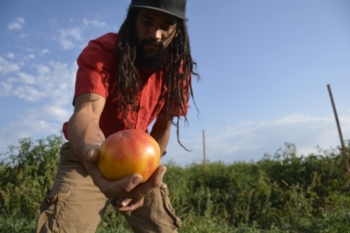
True Roots Organics in Marsing, Idaho. Photo: Mo Valko, Boise Consumer Co-op
There are, of course, challenges to sourcing from small and medium local growers. Price is often a challenge, and weather can be unpredictable. The co-op sources from some beginning farmers who are not as familiar with their piece of land as more experienced growers. Sometimes the co-op can assist its growers in times of need, such as when a farmers had a bad freeze and the co-op was able to invest money into the farmer’s orchard. The Boise Co-op is committed to this work because, as Valko happily says, “The relationships we’ve built have been awesome. We’re able to visit the farms and get to know the producers, and the quality is just phenomenal” (Valko, 2017).
Conclusion
These case studies are strong examples of intermediaries that look to build a relationship with their farmer. Not all intermediaries (retailers, restaurants, food hubs, and institutions) may be as proactive. It might be up to you to show your certifications, your food safety plan, and your ability to meet their customers’ demands. It might be up to you to establish a communications plan with your buyer. No matter whom you sell to, there are two key lessons to be learned from these case studies:
- Communication is key. All of the case studies here emphasize the relationship. That relationship between you and your buyer is built on good communication.
- Quality and consistency are expected. Each of these buyers relies on the farmer to provide a quality product again and again. They demand from their farmers proof of quality in the form of certifications. In many cases, the quality demanded from the farmer is higher than the farmer was previously working with, especially if the farmer operated at a smaller scale, or only sold directly to the consumer. In addition to quality, these buyers rely on the consistency of product. They are looking for a farmer who can deliver as promised, on-time, every-time.
One final thought: in many cases, the buyer and the farmer are working together and depending on each other to make the final sale. Imagine the restaurant that advertises itself with the neighboring farmer’s beef. The restaurant relies on the farmer for the quality and consistency of product, and the farmer relies on the restaurant for a consistent market of customers willing to pay a premium for local food. Intermediated markets provide farmers an opportunity to keep their local identity, but scale up to a point where they can start moving wholesale-like quantities. It’s an opportunity to diversify income streams and make the farm business more relevant. These markets are unique because, throughout the chain, everyone is dedicated to one thing: the importance of local food.
Further Resources
ATTRA Resources
Evaluating a Farming Enterprise This publication will help readers with developing an enterprise that works with their property and goals, and with determining what to grow and how to sell it. Food Hubs: A Producer Guide Local and regional food hubs are improving market access for farmers and ranchers by providing aggregation, storage, processing, distribution, and marketing services to local producers. This publication focuses on providing producers with information, resources, and case studies specific to understanding how food hubs can provide new marketing outlets. NCAT Marketing Tip Sheet Series This series of tip sheets identifies considerations for selling in to direct, intermediated, and wholesale markets. Scaling Up Your Vegetable Farm for Regional Markets This publication helps farmers decide if they are ready to expand their operations to serve intermediated and wholesale markets, or to produce more for direct markets. It addresses important considerations such as land, labor, food safety, marketing, and insurance. Tips for Selling to Restaurants In this publication, growers from around the country illustrate successful strategies and points to remember when working with chefs. Connecting with Institutional Buyers: Strategies and Programs for Producers Presenters in this video discuss key components of working with institutional buyers. Topics covered include food safety, sales agreements, working with cooperatives, contracts and forward buying, and working with aggregators and distributors. A case study of the Harvest of the Month program is discussed. Food Safety This section of ATTRA’s website contains helpful information on the Food Safety Modernization ACT (FSMA) and resources for on-farm food safety, including GAP audits. Produce Safety Tutorial This tutorial serves as an introduction to food-safety topics for produce growers, with information on FSMA rules, GAP certification, and writing a farm food-safety plan. Scaling Up for Regional Markets Tutorial This tutorial provides lessons and information for farmers who have achieved success in smaller and more direct marketing channels and who are interested in expanding their operations to meet a growing demand for local food.
Other Resources
Baskets to Pallets 2016. Violet Stone, Project Coordinator. Cornell University, Ithaca, NY. The Baskets to Pallets training program offers a series of presentations, discussions, activities, videos, and other teaching resources intended to help prepare small and mid-scale farmers to enter food hubs, groceries, restaurants, and cooperatives. Contracting in Agriculture: Making the Right Decision 2017. Drake University, Farm Service Agency, and National Sustainable Agriculture Coalition. This guide is designed to help you understand production contracts, and to help identify the questions you should consider as you decide whether contracting is right for you. Farm Commons Farm Commons offers a wealth of resources and legal services for building local food systems. Guide to Marketing Channel Selection: How to Sell Through Wholesale & Direct Marketing Channels 2014. By Matt LeRoux. Cornell Cooperative Extension of Tompkins County, Ithaca, NY. This publication serves as a decision-making aid for new farmers and for those considering marketing through a new channel. The guide focuses on describing the marketing of fresh-market produce; however, many of the principles apply to the marketing of other agricultural products, including cut flowers, meats, honey, maple syrup, and dairy products. Livestock Compass: Pointing You on the Path to Profitability 2019. Center for Integrated Agricultural Systems. University of Wisconsin-Madison, Madison, WI. This spreadsheet tool is designed to help the reader understand the costs of production and marketing livestock in order to make important decisions that will lead to a more profitable farm business. National Agricultural Law Center The National Agricultural Law Center, a unit of the University of Arkansas, Division of Agriculture, is a leading source for agriculture and food law research and information. Understanding Food Quality Labels: A Guide to AMS Grade Shields, Value-Added Labels, and Official Seals U.S. Department of Agriculture, Agricultural Marketing Service, Washington, D.C. This fact sheet provides information on the food labels and standards that the USDA-AMS verifies. U.S. Department of Agriculture, Agricultural Marketing Service The Agricultural Marketing Service (AMS) administers programs that create marketing opportunities for U.S. producers of food, fiber, and specialty crops. AMS also provides the agriculture industry with valuable services to ensure the quality and availability of wholesome food for consumers across the country. Compass Tools: Whole-Farm Profit Management Center for Integrated Agricultural Systems. University of Wisconsin-Madison, Madison, WI Compass Tools are free downloadable spreadsheets for vegetable, livestock, and organic grain producers. These tools help farmers actively manage for increased farm profits by helping them understand their cost of production, by product and by market channel. This enables farmers to make strategic decisions to adjust prices, reduce costs, shift market channel focus, reduce or drop unprofitable products, and expand production of their most profitable ventures. Wholesale Success: A Farmer’s Guide to Food Safety, Selling, Postharvest Handling, and Packing Produce, 5th Edition 2017. Edited by Jim Slama and Atina Diffley. Family Farmed, Chicago, IL. This guide provides information for farmers selling into wholesale (and intermediated) markets. It details best practices in food safety, postharvest handling, packing, and business management. Intermediated Markets Case Studies By Karen Gardner, New York University, and Andy Pressman, NCAT Agriculture Specialist IP561 This publication is produced by the National Center for Appropriate Technology through the ATTRA Sustainable Agriculture program, under a cooperative agreement with USDA Rural Development. ATTRA.NCAT.ORG.

